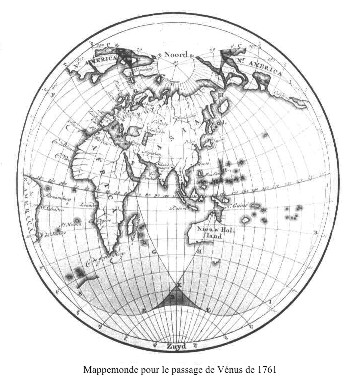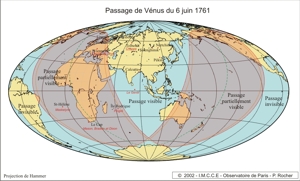
For this passage, the whole astronomical community was mobilized. To the difficulties due to the voyages, came to be added the seven-year war, quasi-world conflict which set ablaze not only Europe but also the seas and the colonies.
The mobilization of the astronomers for the observation of this passage was made by Delisle who sent, all over the world, his map of the visibility of the passage of 1761 to more than one hundred correspondents.

In France, the Académie Royale des sciences organized three campaigns of observations. Two of these campaigns took place in countries allied of France. César-François Cassini de Thury (1714-1784) went to Vienna and made the observation with the archiduc Joseph; Jean Chappe d'Auteroche (1728-1769) was invited to go toTobolsk in Siberia by the tzarina Elisabeth. The third campaign was the one of Alexandre Guy Pingré (1711-1796) who went to Rodrigues Island (north of Madagascar) reachable through the compagnie des Indes. A fourth astronomer, Guillaume Joseph Hyacinthe Jean-Batiste Le Gentil de La Galaisière (1725-1792), went by sea to Pondichéry in the Indies in order to observe the transit; unfortunately, his travel was interrupted: the city of Pondichéry was taken by the English! His ship went back to the île de France (nowadays Mauritius Island) where Le Gentil decided to wait the next transit eight years later. At last, the astronomer Joseph-Jérôme Lefrançois de Lalande (1732-1807) made the observation from the palais du Luxembourg in Paris.
The english astronomers organized two campaigns of observation far from England. Nevil Maskelyne (1732-1811) went to Sainte-Hélène Island where he was not able to observe the transit because of the bad weather. A second team, composed of Charles Mason (1728-1786), James Bradley (1693-1762) and Jeremiah Dixon (1733-1779) was supposed to observe from Bencoolen (Sumatra). In fact, they observed the transit near Capetown, Bencoolen having been taken by the French! John Winthrop, professor in Harvard went to Saint-John (Terre-Neuve) where "entouré de milliards d'insectes décidés à saboter sa besogne"(note 1) he succeeded to observe the last contact of the transit.
Other countries decided to participate to the campaign. The german Maximilien Hell made the observation from Vienna, the swedish Petr Wargentin at Stockholm, the danish Christian Horrebow at Copenhague, the italian Eustacio Zanotti at Bologne, the portugese De Almeida at Porto, the dutch Johan Lulofs at Leiden, Jan de Munck at Middelburg, Dirk Klinkenberg at Den Haag and, at last, Johan Maurits Mohr at Batavia (Jakarta). The total number of professional observers for this transit was 120, on 62 sites (S. Newcomb, 1890). It is interesting to note that some of the sites of observation have been selected by Halley (Bencoolen, Pondichéry, Batavia) in 1716.
 |
| Visibility of the transit of 1761, projection of Hammer |
The results were rather disappointing, the values found for the solar parallax varied from 8.5"to 10.5" according to the authors who made the reductions of the observations. This great margin of error is due to two principal causes, a bad knowledge of longitudes of the sites of observation and the phenomenon known as of the black drop which distorted the determination of the moments of the first and the last interior contact.
During the first observations of the Mercury transits in front of the Sun, one saw a bright point in the center of the black disc of planet. This point shining was interpreted as a volcano in eruption and as an optical illusion by others. It actually acts as a figure of diffraction whose theory can be completely carried out and the phenomenon reproduced in laboratory. This phenomenon appeared when one reduced the aperture of the instruments with a diaphragm and the phenomenon disappeared when one observed with full aperture. The phenomenon known as the black drop, which disturbed the observations of the interior contacts of the Venus transits is also observable in the case of the Mercury transits. This phenomenon is due to diffraction and can be reproduced and photographed in laboratory. "When the planet enters on the disc of the Sun, diffraction rounds the two brilliant points which are closed again behind it, and which actually are well frayed. When they are about to meet, Mercury seems attached to the solar edge by a kind of stalk, as a drop which will be detached from a narrow opening... For observing this phenomenon, it is necessary to employ an enlargement definitely higher than the solving enlargement, calculated for the free aperture of the refractor. If this aperture is 10 centimetres, for example, an enlargement of at least 150 times is necessary. Like the alleged Mercury volcano, the black drop can be easily reproduced at the laboratory and be photographed." (A. Couderc and A. Danjon, 1969). You can reproduce this phenomenon by bringing closer the inch and the index located at ten centimetres of your eyes and placed in front of an intense source of light (the sky, for example).
The observation of the passage of 1761 allowed to suspect the existence of
an atmosphere around the Venus planet. That resulted in the appearance of a
diffuse aureole around the planet. This aureole, was observed between the external
and interior contacts. The aspect of this aureole varies according to the position
of planet between the external contact and the interior contact. If one notes
p the proportion of the Venus diameter outside the solar disc, the aureole is
often described like total in the vicinity of p= 0,5; it presents sometimes
an split aspect with variations of light intensity in the vicinity of the directions
of the poles of the planet. It also presents the aspect of a small luminous
pyramid (observation of Rittenhouse at the time of the passage of 1769). These
different aspects will be also noted at the time of the observation of the following
passages and will be explained theoretically by the presence in an atmosphere.
Note 1:
"surrounded by billions of insects decided to sabotage his work"